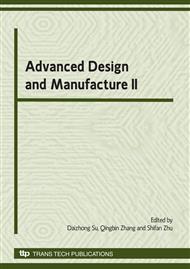p.145
p.149
p.153
p.157
p.161
p.165
p.169
p.173
p.177
Loci Conversion and Corner Smoothing with PH Curves in CNC System
Abstract:
Free-form surface interpolation functions give more advantages in machining than the traditional line and circle functions. A method is developed to convert lines and circles into Pythagorean-hodograph (PH) curves. In order to get smooth machining process the PH curve is used to replace the joints of the circular/linear elements by the connection situation. The slope of line is used to get the tangent vector in the line conversion. When converting a circle to a PH curve, points of the divided circle are introduced to compute the vectors. The methods of computing tangent vectors are proposed according to the slope of the line and the quadrant of the circle. The transformation errors from lines and circles to PH curves are computed. In the corner smoothing process the tangent vectors are computed by the connection between lines and circles. Replacement errors at the joints are computed for the use of PH curve. The results demonstrate the feasibility of the conversion from line and circle to PH curve. The PH curves at the joints of the circular and linear elements show continuous trajectory.
Info:
Periodical:
Pages:
161-164
Citation:
Online since:
October 2009
Authors:
Price:
Сopyright:
© 2010 Trans Tech Publications Ltd. All Rights Reserved
Share:
Citation:


